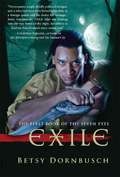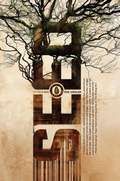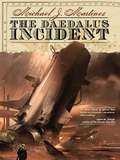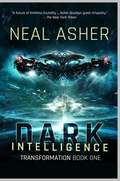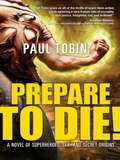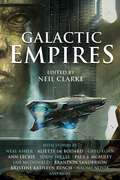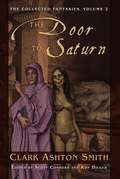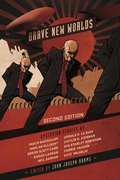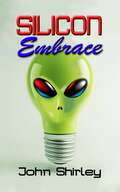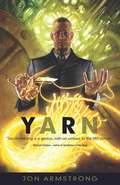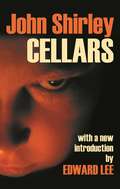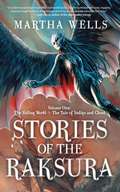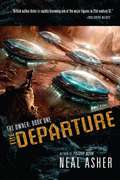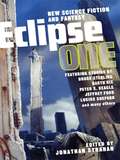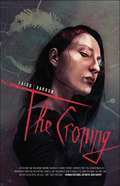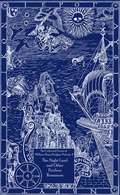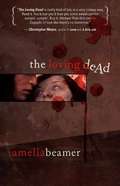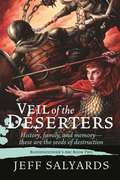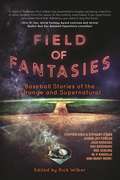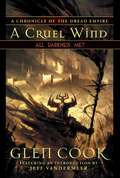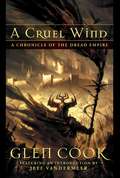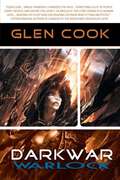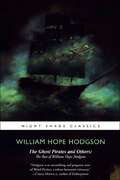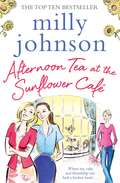- Table View
- List View
Exile
by Betsy DornbuschDraken vae Khellian, bastard cousin of the Monoean King, had risen far from his ignominious origins, becoming both a Bowrank Commander and a member of the Crown&’s Black Guard. But when he is falsely condemned for the grisly murder of his beloved wife, he is banished from the kingdom and cast upon the distant shore of Akrasia, at the arse-end of the world.Compared to civilized Monoea, Akrasia is a forbidding land of Moonlings, magic, and restless spirits. It is also a realm on the brink of a bloody revolution, as a sinister conspiracy plots against Akrasia&’s embattled young queen–and malevolent banes possess the bodies of the living.Consumed by grief, and branded a murderer, Draken lives only to clear his name and avenge his wife&’s murder. But the fates may have bigger plans for him. Alone in a strange land, he soon finds himself sharing the bed of an enigmatic necromancer and a half-breed servant girl, while pressed into the service of a foreign queen whose life and land may well depend on the divided loyalties of an exiled warrior . . .Exile is the beginning of an ambitious fantasy saga by an acclaimed new author.
Seed
by Rob ZieglerIt's the dawn of the 22nd century, and the world has fallen apart. Decades of war and resource depletion have toppled governments. The ecosystem has collapsed. A new dust bowl sweeps the American West. The United States has become a nation of migrants -starving masses of nomads who seek out a living in desert wastelands and encampments outside government seed-distribution warehouses.In this new world, there is a new power. Satori is more than just a corporation, she is an intelligent, living city that grew out of the ruins of Denver. Satori bioengineers both the climate-resistant seed that feeds a hungry nation, and her own post-human genetic Designers, Advocates, and Laborers. What remains of the United States government now exists solely to distribute Satori seed; a defeated American military doles out bar-coded, single-use Satori seed to the nation's starving citizens.When one of Satori's Designers goes rogue, Agent Sienna Doss-Ex-Army Ranger turned glorified bodyguard-is tasked by the government to bring herin: The government wants to use the Designer to break Satori's stranglehold on seed production and reassert themselves as the center of power.Sianna Doss's search for the Designer intersects with Brood and his younger brother Pollo - orphans scrapping by on the fringes of the wastelands. Pollo is abducted, because he is believed to suffer from Tet, a newly emergent disease, the victims of which are harvested by Satori.As events spin out of control, Brood and Sienna Doss find themselves at the heart of Satori, where an explosive climax promises to reshape the future of the world.
The Daedalus Incident
by Michael MartinezMars is supposed to be dead…a fact Lt. Shaila Jain of the Joint Space Command is beginning to doubt in a bad way.Freak quakes are rumbling over the long-dormant tectonic plates of the planet, disrupting its trillion-dollar mining operations and driving scientists past the edges of theory and reason. However, when rocks shake off their ancient dust and begin to roll—seemingly of their own volition—carving canals as they converge to form a towering structure amid the ruddy terrain, Lt. Jain and her JSC team realize that their realize that their routine geological survey of a Martian cave system is anything but. The only clues they have stem from the emissions of a mysterious blue radiation, and a 300-year-old journal that is writing itself.Lt. Thomas Weatherby of His Majesty&’s Royal Navy is an honest 18th-century man of modest beginnings, doing his part for King and Country aboard the HMS Daedalus, a frigate sailing the high seas between continents…and the immense Void between the Known Worlds. Across the Solar System and among its colonies—rife with plunder and alien slave trade—through dire battles fraught with strange alchemy, nothing much can shake his resolve. But events are transpiring to change all that.With the aid of his fierce captain, a drug-addled alchemist, and a servant girl with a remarkable past, Weatherby must track a great and powerful mystic, who has embarked upon a sinister quest to upset the balance of the planets—the consequences of which may reach far beyond the Solar System, threatening the very fabric of space itself.Set sail among the stars with this uncanny tale, where adventure awaits, and dimensions collide!
Dark Intelligence (Transformations)
by Neal AsherOne man will transcend death to seek vengeance. One woman will transform herself to gain power. And no one will emerge unscathed...Thorvald Spear wakes in a hospital to find he's been brought back from the dead. What's more, he died in a human vs. alien war that ended a century ago. Spear had been trapped on a world surrounded by hostile Prador forces, but Penny Royal, the AI inside the rescue ship sent to provide backup, turned rogue, annihilating friendly forces in a frenzy of destruction and killing Spear. One hundred years later the AI is still on the loose, and Spear vows for revenge at any cost.Isobel Satomi ran a successful crime syndicate, but after competitors attacked she needed power and protection. Negotiating with Penny Royal, she got more than she bargained for: Turning part-AI herself gave Isobel frightening power, but the upgrades hid a horrifying secret, and the dark AI triggered a transformation that has been turning her into something far from human…Spear hires Isobel to track Penny Royal across worlds to its last known whereabouts. But he cheats her in the process and quickly finds himself in her crosshairs. As Isobel continues to evolve into a monstrous predator, it&’s clear her rage will eventually win out over reason. Will Spear finish his hunt before he himself becomes the hunted?Dark Intelligence is the explosive first novel in a brand new trilogy from military SF master Neal Asher and a new chapter in his epic Polity universe.
Prepare to Die!
by Paul TobinNine years ago, Steve Clarke was just a teenage boy in love with the girl of his dreams. Then a freak chemical spill transformed him into Reaver, the man whose super-powerful fists can literally take a year off a bad guy&’s life.Days ago, he found himself at the mercy of his arch-nemesis Octagon and a whole crew of fiendish super-villains, who gave him two weeks to settle his affairs–and prepare to die.Now, after years of extraordinary adventures and crushing tragedies, the world&’s greatest hero is returning to where it all began in search of the boy he once was . . . and the girl he never forgot.Exciting, scandalous, and ultimately moving, Prepare to Die! is a unique new look at the last days of a legend.
Binding: Book Two of the Moon Wolf Saga
by Carol WolfWhat do you do after you&’ve saved the world—and nobody believes you?Amber is a teenage runaway, hiding out in Los Angeles, who is also a daughter of the wolf kind. And, not long ago, she had her own personal demon. Richard was her servant, her lover, and a hellish force bound to the earth against his will. Together they turned back the World Snake that threatened to destroy the city—and she had granted Richard his freedom.Now Amber is alone, but nobody accepts that she has truly shed her demon. Many still fear the World Snake and seek to capture the demon&’s power for their own purposes, unaware that Richard has already departed the mortal realm. Amber finds herself hunted, in both wolf and human forms, by cultists, illusionists, raisers of power, and even an evil veterinarian.Saving the world was one thing. To save herself, Amber may have to call back her fearsome demon lover, who is no longer bound to obey her . . .
Galactic Empires
by Neil ClarkeNeil Clarke, publisher of the award-winning Clarkesworld magazine, presents a collection of thought-provoking and galaxy-spanning array of galactic short science fiction. From E. E. "Doc" Smith&’s Lensman, to George Lucas&’ Star Wars, the politics and process of Empire have been a major subject of science fiction&’s galaxy-spanning fictions. The idiom of the Galactic Empire allows science fiction writers to ask (and answer) questions that are shorn of contemporary political ideologies and allegiances. This simple narrative slight of hand allows readers and writers to see questions and answers from new and different perspectives. The stories in this book do just that. What social, political, and economic issues do the organizing structure of &“empire&” address? Often the size, shape, and fates of empires are determined not only by individuals, but by geography, natural forces, and technology. As the speed of travel and rates of effective communication increase, so too does the size and reach of an Imperial bureaucracy.Sic itur ad astra—&“Thus one journeys to the stars.&” At the beginning of the twentieth century, writers such as Kipling and Twain were at the forefront of these kinds of narrative observations, but as the century drew to a close, it was writers like Iain M. Banks who helped make science fiction relevant. That tradition continues today, with award-winning writers like Ann Leckie, whose 2013 debut novel Ancillary Justice hinges upon questions of imperialism and empire. Here then is a diverse collection of stories that asks the questions that science fiction asks best. Empire: How? Why? And to what effect? Table of Contents: - &“Winning Peace&” by Paul J. McAuley - &“Night&’s Slow Poison&” by Ann Leckie - &“All the Painted Stars&” by Gwendolyn Clare - &“Firstborn&” by Brandon Sanderson - &“Riding the Crocodile&” by Greg Egan - &“The Lost Princess Man&” by John Barnes - &“The Waiting Stars&” by Aliette de Bodard - &“Alien Archeology&” by Neal Asher - &“The Muse of Empires Lost&” by Paul Berger - &“Ghostweight&” by Yoon Ha Lee - &“A Cold Heart&” by Tobias S. Buckell - &“The Colonel Returns to the Stars&” by Robert Silverberg - &“The Impossibles&” by Kristine Kathryn Rusch - &“Utriusque Cosmi&” by Robert Charles Wilson - &“Section Seven&” by John G. Hemry - &“The Invisible Empire of Ascending Light&” by Ken Scholes - &“The Man with the Golden Balloon&” by Robert Reed - &“Looking Through Lace&” by Ruth Nestvold - &“A Letter from the Emperor&” by Steve Rasnic Tem - &“The Wayfarer&’s Advice&” by Melinda M. Snodgrass - &“Seven Years from Home&” by Naomi Novik - &“Verthandi&’s Ring&” by Ian McDonald
The Collected Fantasies of Clark Ashton Smith: The Door To Saturn
by Clark Ashton SmithPublished in chronological order, with extensive story and bibliographic notes, this series not only provides access to stories that have been out of print for years, but gives them a historical and social context. Series editors Scott Conners and Ronald S. Hilger excavated the still-existing manuscripts, letters and various published versions of the stories, creating a definitive &“preferred text&” for Smith's entire body of work. This second volume of the series brings together 20 of his fantasy stories.
Brave New Worlds
by John Joseph AdamsYou are being watched.Your every movement is being tracked, your every word recorded. Your spouse may be an informer, your children may be listening at your door, your best friend may be a member of the secret police. You are alone among thousands, among great crowds of the brainwashed, the well-behaved, the loyal. Productivity has never been higher, the media blares, and the army is ever triumphant. One wrong move, one slip-up, and you may find yourself disappeared -- swallowed up by a monstrous bureaucracy, vanished into a shadowy labyrinth of interrogation chambers, show trials, and secret prisons from which no one ever escapes. Welcome to the world of the dystopia, a world of government and society gone horribly, nightmarishly wrong.What happens when civilization invades and dictates every aspect of your life? From 1984 to The Handmaid's Tale, from Children of Men to Bioshock, the dystopian imagination has been a vital and gripping cautionary force. Brave New Worlds collects the best tales of totalitarian menace by some of today's most visionary writers, including Neil Gaiman, Paolo Bacigalupi, Orson Scott Card, Kim Stanley Robinson, and Ursula K. Le Guin.When the government wields its power against its own people, every citizen becomes an enemy of the state. Will you fight the system, or be ground to dust beneath the boot of tyranny?
Silicon Embrace
by John ShirleyA near-future where technology and ancient spiritual secrets merge into something very strange... something as strange as a silicon embrace. America has suffered ecological breakdown and the Second Civil War. But the balkanization of the U.S.—along with humanity&’s secret history and what has really been going on in Area 51 and UFOs for decades—are all part of a startling convergence which will transform humanity... or destroy it.* * *Reviews:&“John Shirley has written the best novel of his career. Mature yet youthfully indignant, spiritually insightful yet carnally streetwise, his new book is aboil with ideas and action, full of keen-eyed speculations for the future and daring revisions of history.&”—Asimov&’s&“Silicon Embrace is at once sly, sad eloquent, gonzo, mystic, surreal, and all-American, mixing the pulpiest Sci-Fi with true literary sophistication. A new gem from John Shirley.—Locus&“Angels and aliens alike figure in this metaphysical SF novel from proto-cyberpunker Shirley, who here throws UFOs, black helicopters, several major biblical figures and spiritual transcendence into the early 21st century... it's clear that the author is having fun tying together disparate UFO, conspiracy and New Age myths; readers will have fun watching him do the tying, too.&”—Publishers Weekly
Yarn
by Jon ArmstrongFrom the neo-feudalistic slubs, the corn-filled world of Tane's youth, to his apprenticeship among the deadly saleswarriors of Seattlehama—the sex-and-shopping capital of the world—to the horrors of a polluted Antarctica, Yarn tells a stylish tale of love, deceit, and memory.Tane Cedar is the master tailor, the supreme outfitter of the wealthy, the beautiful, and the powerful. When an ex-lover, on the run from the authorities, asks him to create a garment from the dangerous and illegal Xi yarn—a psychedelic opiate—to ease her final hours, Tane's world is torn apart.Armed with just his yarn pulls, scissors, Mini-Air-Juki handheld sewing machine, and his wits, Tane journeys through the shadowy underworld where he must untangle the deadly mysteries and machinations of decades of deceit.Following up on his highly acclaimed and Philip K. Dick Award-nominated Grey, Jon Armstrong explodes back on the scene with Yarn.
Cellars
by John ShirleyAn ancient evil deep beneath New York City turns subway stations into bloody altars for ritual sacrifice. Monsters made of blood arise from drains, an invisible hellhound devours human flesh, feral children stalk the shadowy streets and make murder a terrifying game. Occult investigator Carl Lanyard risks his life, his love, and his sanity as he battles the unspeakable forces of darkness. A modern classic by a master of the macabre in a new revised edition.
Stories of the Raksura: The Falling World & The Tale of Indigo and Cloud
by Martha WellsIn &“The Falling World,&” Jade, sister queen of the Indigo Cloud Court, has traveled with Chime and Balm to another Raksuran court. When she fails to return, her consort, Moon, along with Stone and a party of warriors and hunters, must track them down. Finding them turns out to be the easy part; freeing them from an ancient trap hidden in the depths of the Reaches is much more difficult.&“The Tale of Indigo and Cloud&” explores the history of the Indigo Cloud Court, long before Moon was born. In the distant past, Indigo stole Cloud from Emerald Twilight. But in doing so, the reigning Queen Cerise and Indigo are now poised for a conflict that could spark war throughout all the courts of the Reaches.Stories of Moon and the shape changers of Raksura have delighted readers for years. This world is a dangerous place full of strange mysteries, where the future can never be taken for granted and must always be fought for with wits and ingenuity, and often tooth and claw. With two brand-new novellas, Martha Wells shows that the world of the Raksura has many more stories to tell . . .
The Departure (The Owner)
by Neal AsherVisible in the night sky the Argus Station, its twin smelting plants like glowing eyes, looks down on nightmare Earth. From Argus the Committee keep an oppressive control: citizens are watched by cams systems and political officers, it's a world inhabited by shepherds, reader guns, razor birds and the brutal Inspectorate with its white tiled cells and pain inducers. Soon the Committee will have the power to edit human minds, but not yet, twelve billion human being need to die before Earth can be stabilized, but by turning large portions of Earth into concentration camps this is achievable, especially when the Argus satellite laser network comes fully online . . . This is the world Alan Saul wakes to in his crate on the conveyor to the Calais incinerator. How he got there he does not know, but he does remember the pain and the face of his interrogator. Informed by Janus, through the hardware implanted in his skull, about the world as it is now Saul is determined to destroy it, just as soon as he has found out who he was, and killed his interrogator . . .
Eclipse 1
by Jonathan StrahanAn eclipse is a rare and unusual event, when the world is transformed and the sky becomes a dark eldritch thing. It's a time when anything could happen, when any kind of story just might be true. That sense of the strange and wonderful guides Eclipse: New Science Fiction and Fantasy, the first volume in an exciting new annual anthology series edited by acclaimed anthologist Jonathan Strahan.Set to become a major event on the science fiction and fantasy calendar,Eclipse: New Science Fiction and Fantasy gathers together new science fiction and fantasy stories by the best writers working today. You can see that in Eclipse 1, which features extraordinary tales by Peter S. Beagle, Jack Dann & Paul Brandon, Terry Dowling, Andy Duncan, Jeffrey Ford, Kathleen Ann Goonan, Eileen Gunn, Gwyneth Jones, Ellen Klages, Maureen F. McHugh, Garth Nix, Lucius Shepard, Bruce Sterling and Ysabeau S. Wilce.
The Croning
by Laird BarronStrange things exist on the periphery of our existence, haunting us from the darkness looming beyond our firelight. Black magic, weird cults and worse things loom in the shadows. The Children of Old Leech have been with us from time immemorial. And they love us...Donald Miller, geologist and academic, has walked along the edge of a chasm for most of his nearly eighty years, leading a charmed life between endearing absent-mindedness and sanity-shattering realization. Now, all things must converge. Donald will discover the dark secrets along the edges, unearthing savage truths about his wife Michelle, their adult twins, and all he knows and trusts. For Donald is about to stumble on the secret......of The Croning.From Laird Barron, Shirley Jackson Award-winning author of The Imago Sequence and Occultation, comes The Croning, a debut novel of cosmic horror.
The Collected Fiction of William Hope Hodgson: The Night Land & Other Romances
by William Hope HodgsonThe fourth of a five volume set collecting all of Hodgson's published fiction. Each volume contains one of Hodgson's novels, along with a selection of thematically-linked short fiction.
The Loving Dead
by Amelia BeamerKate and Michael are roommates living in the Oakland hills, working at the same Trader Joes supermarket. A night of drunken revelry changes their lives forever, but not in the way that anyone would expect. A slow-spreading plague of zombie-ism breaks out at their house party, spreading amongst their circle of friends, and simultaneously through the Bay Area. This zombie plague — an STD of sorts — is spread through sex and kissing, turning its victims into mindless, horny, voracious killers. Thrust into extremes by this slow- motion tragedy, Kate and Michael are forced to confront the choices they&’ve made in their lives, and their fears of commitment, while trying to stay alive and reunite in the one place in the Bay Area that&’s likely to be safe and secure from the zombie hoards: Alcatraz.
Veil of the Deserters (Bloodsounder's Arc)
by Jeff SalyardsBraylar is still poisoned by the memories of those slain by his unholy flail Bloodsounder, and attempts to counter this sickness have proven ineffectual. The Syldoonian Emperor, Cynead, has solidified his power in unprecedented ways, and Braylar and company are recalled to the capital to swear fealty. Braylar must decide if he can trust his sister, Soffjian, with the secret that is killing him. She has powerful memory magics that might be able to save him from Bloodsounder&’s effects, but she has political allegiances that are not his own. Arki and others in the company try to get Soffjian and Braylar to trust one another, but politics in the capital prove to be complicated and dangerous. Deposed emperor Thumarr plots to remove the repressive Cynead, and Braylar and Soffjian are at the heart of his plans. The distance between &“favored shadow agent of the emperor&” and &“exiled traitor&” is unsurprisingly small. But it is filled with blind twists and unexpected turns. Before the journey is over, Arki will chronicle the true intentions of Emperor Cynead and Soffjian.
Field of Fantasies: Baseball Stories of the Strange and Supernatural
by Rick WilberOf all the sports played across the globe, none has more curses, superstitions, or supernatural events like baseball, America&’s national pastime. While some of these can easily be explained, there are just as many that cannot.Field of Fantasies delves right into that superstition with short stories written by several key authors about baseball and the supernatural. Whether it&’s a frozen curveball, a robot pitcher, or fantasy outcomes (the Cubs winning the World Series!), these terrific stories are ones that fans of science fiction will enjoy, while fans of baseball will find strangely believable.Included in this wonderful anthology are stories from such prolific authors as:Stephen KingJack KerouacKaren Joy FowlerRod SerlingW. P. KinsellaAnd many more!Never has a book combined the incredible events of baseball and science fiction like Field of Fantasies does. Whether you&’re a sport or science fiction fan, these stories will appeal not only to your fandom, but also to your appreciation and acceptance of the unknown taking place on the baseball diamond. If you&’ve ever held a bat or glove in your hand (or just watched the game on TV), you&’ll be enthralled by these terrific tales that range from the sandlot to the sold-out stadium.
All Darkness Met
by Glen CookBefore there was Black Company, there was the Dread Empire, an omnibus collection the first three Dread Empire novels: A Shadow of All Night's Falling, October's Baby and All Darkness Met. For the first time in eBook format, the A Cruel Wind collection is available as individual books.
A Cruel Wind
by Glen CookBefore there was Black Company, there was the Dread Empire, an omnibus collection the first three Dread Empire novels: A Shadow of All Night's Falling, October's Baby and All Darkness Met.
Warlock: Book Two of The Dark War Trilogy (Darkwar Trilogy #2)
by Glen CookThe world grows colder with each passing year, the longer winters and ever-deepening snows awaking ancient fears within the Dengan Packstead, fears of invasion by armed and desperate nomads, attack by the witchlike and mysterious Silth, able to kill with their minds alone, and of the Grauken, that desperate time when intellect gives way to buried cannibalistic instinct, when meth feeds upon meth. For Marika, a young pup of the Packstead, loyal to pack and family, times are dark indeed, for against these foes, the Packstead cannot prevail. But awakening within Marika is a power unmatched in all the world, a legendary power that may not just save her world, but allow her to grasp the stars themselves. From Glen Cook, author of the Black Company and Dread Empire novels. The second book in the Darkwar series.
Ghost Pirates and Others
by William Hope HodgsonWilliam Hope Hodgson was a contemporary of H. P. Lovecraft, and Clark Ashton Smith, and was one of the most important and influential fantasists of the 20th century. His novel The Ghost Pirates is a take-no-prisoners supernatural adventure story that is just as powerful today as it was 100 years ago.In addition to his landmark novel, this volume contains some of his most influential short fiction; from his supernatural detective Thomas Carnacki to tales of the mysterious Sargasso Sea. The Ghost Pirates and Others is the perfect introduction to the magic, mystery and adventure of William Hope Hodgson.
Afternoon Tea at the Sunflower Café
by Milly JohnsonThe heartwarming and feel-good read from the Sunday Times bestselling author&‘The feeling you get when you read a Milly Johnson book should be bottled and made available on the NHS&’ Debbie Johnson When Connie discovers that Jimmy Diamond, her husband of more than twenty years, is planning to leave her for his office junior, her world is turned upside down. Determined to salvage her pride, she resolves to get her own back. Along with Della, Jimmy's right-hand woman at his cleaning firm, Diamond Shine, and the cleaners who meet at the Sunflower Café, she'll make him wish he had never underestimated her. Then Connie meets the charming Brandon Locke, a master chocolatier, whose kindness starts to melt her soul. Can the ladies of the Sunflower Cafe help Connie scrub away the hurt? And can Brandon make her trust again?Praise for Milly Johnson: 'Every time you discover a new Milly book, it&’s like finding a pot of gold' heat 'A glorious, heartfelt novel' Rowan Coleman &‘Absolutely loved it. Milly's writing is like getting a big hug with just the right amount of bite underneath. I was rooting for Bonnie from the start' Jane Fallon &‘Bursting with warmth and joie de vivre&’ Jill Mansell &‘Warm, optimistic and romantic&’ Katie Fforde
